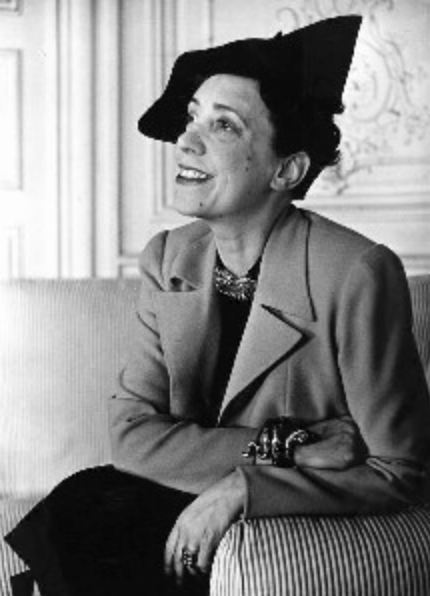
The Fascinating and Visionàire Italian Designer, Elsa Schiaparelli
Elsa Schiaparelli was an Italian fashion designer who, along with her rival Coco Chanel, is regarded as one of the most prominent figures in fashion between the two World Wars.
Schiaparelli was born in 1890 and raised in Rome, Italy. The cultural background and erudition of her family members served to ignite the imaginative faculties of Schiaparelli’s impressionable childhood years. She became enraptured with the lore of ancient cultures and religious rites. The content of her writing alarmed the conservative sensibilities of her parents, so they sought to tame her fantasy life by sending her to a convent boarding school in Switzerland. Once within the school’s confines, Schiaparelli rebelled against its strict authority by going on a hunger strike, leaving her parents no alternative but to bring her home again.
Schiaparelli was dissatisfied by a lifestyle that was refined, but ultimately cloistered and unfulfilling. Her craving for an exploration of the wider world led her to try to remedy this and when a friend offered her a post caring for orphaned children in an English country house, she saw her opportunity to leave. The placement, however, proved uncongenial to Schiaparelli. She subsequently planned a return to the stop-over city of Paris rather than admit defeat by returning to Rome and her family.
She married a charlatan, whom she got engaged after one day of dating. They moved to NY in 1916 and their lives were followed by FBI and others suspicious of his career credits along and spy actions during war times. Soon after Schiaparelli and then husband Dr. Kerlor had their daughter in 1920, he left them behind. So, in 1922, she moved back to France with her daughter "Gogo". Schiaparelli relied greatly on the emotional support offered her by her close friend Gabrielle 'Gaby' Buffet-Picabia, the wife of Dada/Surrealist artist Francis Picabia.
Schiaparelli’s design career was influenced by couturier Paul Poiret, who was renowned for jettisoning corseted, over-long dresses and promoting styles that enabled freedom of movement for the modern, elegant and sophisticated woman. In later life, Schiaparelli referred to Poiret as "a generous mentor, dear friend."
Schiaparelli had no training in the technical skills of pattern making and clothing construction. Her method of approach relied on both impulse of the moment and the serendipitous inspiration as the work progressed. She draped fabric directly on the body, sometimes using herself as the model. This technique followed the lead of Poiret who too had created garments by manipulating and draping. The results appeared uncontrived and wearable.
Schiaparelli was also renowned for her unusual buttons, which could resemble candlesticks, playing card emblems, ships, crowns, crickets, or silver tambourines. Many of these fastenings were designed by Jean Clement and Roger Jean-Pierre, who also created jewellery for her. In 1936, Schiaparelli was one of the first people to recognise the potential of Jean Schlumberger, who she originally employed as a designer of buttons.
Schiaparelli's output also included distinctive costume jewellery in a wide range of novelty designs. One of her most directly Surrealist designs was a 1938 Rhodoid (a newly developed clear plastic) necklace studded with coloured metallic insects by Clément, giving the illusion that the bugs were crawling directly on the wearer's skin. During the 1930s, her jewellery designs were mostly produced by Schlumberger, Clemént and Jean-Pierre.
Schlumberger's jewellery, with its inventive combinations of precious and semi-precious stones proved successful, prompted him to launch his jewellery business in New York at the end of the '30s. Schiaparelli also offered brooches by Alberto Giacometti, fur-lined metal cuffs by Méret Oppenheim, and pieces by Max Boinet, Lina Barrette, and the writer Elsa Triolet. Compared to her unusual couture 1930s pieces, 1940s and 1950s Schiaparelli jewellery tended to be more abstract or floral-themed.
Schiaparelli also designed the wardrobe for several films, including Moulin Rouge in which Gabor played Jane Avril. She famously dressed Mae West for Every Day's a Holiday (1937) using a mannequin based on West's measurements, which inspired the torso bottle for Shocking perfume.
Schiaparelli's fanciful imaginative powers coupled with involvement in the Dada/Surrealist art movements directed her into new creative territory. Her instinctive sensibilities soon came to distinguish her creations from her chief rival Coco Chanel, who referred to her as 'that Italian artist who makes clothes'. Schiaparelli collaborated with a number of contemporary artists, most famously with Salvador Dalí to develop a number of her most notable designs.
The House of Schiaparelli was first opened in the 1930s at 21 Place Vendôme, but was shut down on 13 December 1954. The failure of her business meant that Schiaparelli's name is not as well remembered as that of her great rival Chanel. But in 1934, Time placed Chanel in the second division of fashion, whereas Schiaparelli was one of "a handful of houses now at or near the peak of their power as arbiters of the ultra-modern haute couture....Madder and more original than most of her contemporaries, Mme Schiaparelli is the one to whom the word "genius" is applied most often". Schiaparelli relied on inspiration rather than craftsmanship and, "it was not long before every little dress factory in Manhattan had copied them and from New York's 3rd Avenue to San Francisco's Howard Street millions of shop girls who had never heard of Schiaparelli were proudly wearing her models".
